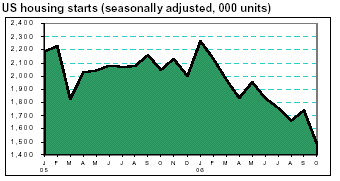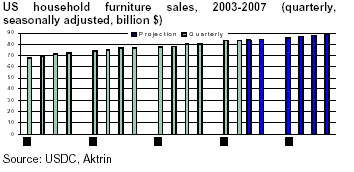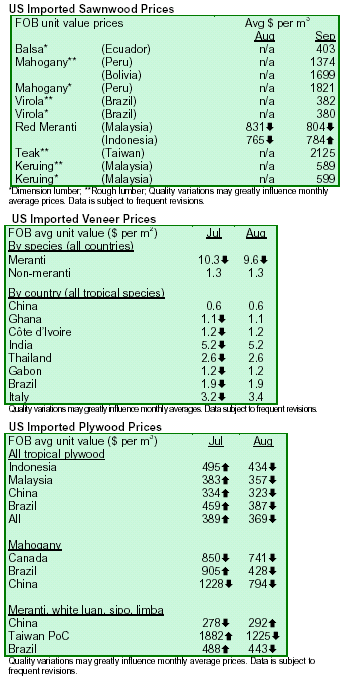|
US housing starts resume downward trend
Privately-owned housing starts fell sharply 14.6% in October to a seasonally adjusted annual rate of 1.49
million units, according to the US Commerce Department. This was the lowest level in more than six years and
27.4% below the pace of a year ago, underlying the sharp downturn in the sector. The decline was due to a 15.9%
drop in the single-family sector, which accounted for about 80% of the houses built. Falling demand and an
oversupply of unsold houses discouraged new housing developments. The chart below shows that
privately-owned housing starts have plunged 34% since January this year. Meanwhile, building permits (down
6.3% from September) and housing completions (down 3.81%) also fell in October. The sharp slowdown in
housing this year stands in stark contrast to the past five years, when the lowest mortgage rates in four decades had powered a housing boom that pushed sales to five
consecutive records.

China exempts products made from imported timber
On 7 November, China revised the regulation reauthorizing the value-added tax (VAT) rebate and dutyfree
preferences (known as the í░processing tradeí▒ preferential trade program) for some re-exported solid
wood products, according to IWPA. China had cut the reexport preferences for a large category of solid wood
products, including veneer and lumber in September this year (see TTM 11:18).
The regulation was refined to specify that raw materials can be imported without the VAT and without duty as
long as the processed products exported are made from imported raw materials. If the final processed products are
exported using domestically-sourced wood, processors
will only receive a partial VAT rebate. The change went into effect on 22 November 2006. The regulation adds a
one-year grace period for those businesses in the í░processing tradeí▒ program to complete their trade
contracts if they have entered into a trade partnership before 22 November 2006.
Legislation on GSP renewal resumes
Legislation was being discussed and drafted in Capitol Hill to renew GSP and other trade preference programs
before expiration on 31 December, according to IWPA. The House and Senate leadership hold the key to renewal
as they will determine if legislation is to be considered in their respective houses. Action on the legislation would
have to occur between 5 and 15 December. Still unknownwas the status of extending the CNL waiver for Indonesian plywood and Brazilí»s participation in a renewed GSP
program.
US consumer spending on household furniture
This two-part article analyzes the current state of the US furniture market. The first part focuses on the household
furniture sector. After a healthy growth of 5.6% (annualized GDP, seasonally adjusted) in the first quarter
of 2006, the US economy slowed to only 2.9% in the second quarter and was predicted to decelerate to under
2.5% in the final two quarters of the year. The average GDP growth for this year as a whole may lie around 3.5%,
which is still higher than the 3.2% rate in 2005. However, next yearí»s growth rate might be at around the 2.7%,
which would be the lowest during the past five years.

Personal income growth is one of the most important leading indicators for predicting furniture consumption.
Helped by increased job creation last year, personal income may hold up better than the economy as a whole.
Income growth stood at 5.2% in 2005, would probably accelerate to 7.1% in 2007 and is forecast by Aktrin to
remain above the 5% mark in 2007. Discounting inflation and taxes, real disposable income would be about 3% this
year (up from 1.2% in 2005) and 2.7% next year. US consumer spending would fall from 3.5% in 2005 to just
above 3% this year, due to higher interest rates, but almost certainly fall below this mark in 2007. The growth rate of
consumption of durable goods is estimated to slow from 5.5% in 2005 to 4.7% in 2006 and decelerate further to
below 3% next year.
The housing market is now oversupplied and with higher low mortgage rates, the growth of residential construction
would probably fall from 9.9% in 2004 and 8.6% in 2005 to -2.1% this year and -5% next year. In volume terms,
this translates to 2.07 million new housing units in 2005 but only an expected 1.88 million in 2006.
Furniture consumption in the USA grew at a rate of 4.7% in 2005. In line with the advances of disposable income,
Aktrin estimates a faster rate of 5.9% in 2006 and a slowdown to 4.3% in 2007. This would bring the market
value to about $84 billion this year and $87 billion next
year.

|